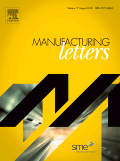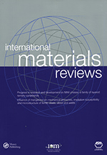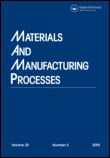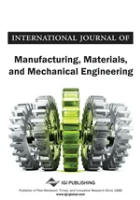
Integrating Materials and Manufacturing Innovation
Scope & Guideline
Fostering Collaboration for Tomorrow's Manufacturing Solutions.
Introduction
Aims and Scopes
- Computational Materials Science:
The journal emphasizes the development and application of computational models to predict material behavior, microstructure evolution, and process parameters, particularly in additive manufacturing and advanced material processing. - Data-Driven Approaches:
There is a strong focus on leveraging big data, machine learning, and artificial intelligence to extract insights from materials data, optimize manufacturing processes, and enhance materials discovery. - Microstructural Characterization:
The journal covers various techniques for detailed microstructural analysis, including advanced imaging methods and automated characterization techniques to understand the relationship between processing, structure, and properties. - Interdisciplinary Research:
The journal encourages contributions that bridge multiple disciplines including materials science, mechanical engineering, and computer science, fostering innovation through collaboration. - Additive Manufacturing Innovations:
A significant portion of the research published addresses challenges and advancements in additive manufacturing technologies, including process optimization, defect analysis, and performance evaluation.
Trending and Emerging
- Machine Learning and AI in Materials Science:
There is a growing trend in employing machine learning and artificial intelligence techniques to enhance materials discovery and process optimization, indicating a shift towards data-driven methodologies. - Digital Twins and Simulation Techniques:
Research related to digital twins and advanced simulation techniques is on the rise, reflecting the industry's focus on real-time monitoring and predictive modeling of material behaviors. - Sustainability and Green Manufacturing:
Emerging themes around sustainable practices and materials are increasingly prevalent, highlighting the industry's response to environmental concerns and the push for more eco-friendly manufacturing processes. - Multiscale Modeling:
The trend towards multiscale modeling approaches is gaining momentum, as researchers seek to understand and predict material behavior across different scales, from atomic to macroscopic levels. - Integration of Advanced Characterization Techniques:
There is an increasing focus on integrating advanced characterization methods, such as synchrotron X-ray diffraction and high-resolution electron microscopy, to provide deeper insights into material properties and behaviors.
Declining or Waning
- Traditional Manufacturing Processes:
Research focusing on conventional manufacturing techniques such as casting or machining is becoming less frequent, as attention shifts towards more advanced and automated processes like additive manufacturing. - Basic Materials Characterization Techniques:
There has been a noticeable reduction in publications centered around traditional materials characterization methods, as more advanced and automated techniques gain traction in research. - Single-Discipline Approaches:
The journal is increasingly favoring interdisciplinary approaches over single-discipline studies, leading to a decline in papers that do not integrate multiple fields of study.
Similar Journals

TEHNICKI GLASNIK-TECHNICAL JOURNAL
Empowering Research in Technical DisciplinesTEHNICKI GLASNIK-TECHNICAL JOURNAL is a peer-reviewed, open-access journal published by UNIV NORTH in Croatia, dedicated to fostering knowledge and innovation in the fields of engineering, computer science applications, and information systems. With an ISSN of 1846-6168 and an E-ISSN of 1848-5588, this journal has been a vital resource for researchers since its transition to open access in 2009, ensuring that valuable insights are freely available to the global academic community. Notably, it has achieved a commendable presence in various Scopus categories, including ranking in the 34th percentile for general engineering and engaging with emerging trends in areas like computer graphics and management information systems. As of 2023, it holds quartile rankings ranging from Q3 in engineering to Q4 in several computer science categories, underlining its diverse scope and relevance. The journal aims to provide a platform for rigorous research, innovative methodologies, and practical applications, making it essential reading for academics, practitioners, and students interested in advancing their understanding and practice in technical disciplines.

International Journal of Precision Engineering and Manufacturing
Driving Progress: Where Research Meets Real-World ApplicationsInternational Journal of Precision Engineering and Manufacturing, published by the Korean Society of Precision Engineering, is a key academic platform dedicated to the advancement of research in the fields of precision engineering and manufacturing. With an ISSN of 2234-7593 and an E-ISSN of 2005-4602, this esteemed journal caters to a diverse readership, including researchers, industry professionals, and students, who are committed to exploring innovative solutions in Electrical and Electronic Engineering, Industrial and Manufacturing Engineering, and Mechanical Engineering. Operating from South Korea, the journal has attained a commendable Q2 ranking in several engineering categories as of 2023, reflecting its influence and relevance in the academic community. Though it is not an open access journal, the International Journal of Precision Engineering and Manufacturing provides vital insights and updates in precision technology, bridging the gap between theory and practice. Researchers are encouraged to contribute to this evolving field and engage with high-quality studies that drive progress and innovation.

Manufacturing Technology
Connecting Research and Practice in ManufacturingManufacturing Technology is a respected journal dedicated to advancing the field of industrial and manufacturing engineering. Published by the Jan Evangelista Purkyne University in the Czech Republic, this journal serves as a vital resource for researchers, professionals, and students interested in the latest developments and technologies in manufacturing processes. With an ISSN of 1213-2489 and E-ISSN 2787-9402, it has carved its niche as a Q3-ranked journal in the 2023 category of Industrial and Manufacturing Engineering on Scopus, showcasing its commitment to high-quality research, evidenced by its standing among the top publications in its field. Although not an open-access journal, it fosters significant academic exchange through its collection of research articles and reviews that span a diverse range of topics. The journal's reach is expanded, having existed for over a decade, with converged years from 2011 to 2024. As manufacturing technologies continue to evolve, Manufacturing Technology remains a key platform for disseminating innovative research, ensuring its relevance and impact within the academic community.

Manufacturing Letters
Pioneering Research for a Sustainable Manufacturing Landscape.Manufacturing Letters is a premier academic journal published by Elsevier, dedicated to advancing the fields of Industrial and Manufacturing Engineering and Mechanics of Materials. Established in 2013, this journal has quickly gained recognition, achieving a Q2 ranking in both disciplines as of 2023, highlighting its significance in the rapidly evolving manufacturing landscape. With an ISSN of 2213-8463, Manufacturing Letters provides a platform for researchers and industry professionals to share critical insights and innovative findings that drive the manufacturing sector forward. The journal is indexed in Scopus, where it ranks in the top 65th percentile for Industrial and Manufacturing Engineering and the 61st percentile for Mechanics of Materials, reflecting its impact in the scientific community. While primarily accessible through subscription, Manufacturing Letters aims to facilitate knowledge exchange, promote sustainable practices, and foster collaboration among individuals passionate about enhancing manufacturing efficiency and material development. This journal is indispensable for anyone looking to contribute to or understand the future of manufacturing.

Metallography Microstructure and Analysis
Charting New Territories in Metallurgical AnalysisWelcome to Metallography Microstructure and Analysis, a prominent journal dedicated to the exploration of microstructural properties and their implications in metallic materials. Published by SpringerNature, this journal stands at the forefront of research in the field of materials science, particularly focusing on metals and alloys. With an impressive Q2 ranking in 2023 within its category and a Scopus rank of #72 out of 176, it continues to provide significant contributions to the understanding of metallography, attracting diverse readership among researchers, industry professionals, and students alike. The journal spans a converged period from 2012 to 2024, ensuring it captures the evolving landscape of metallurgical studies. Although it does not currently offer open access, this platform is essential for disseminating high-quality, peer-reviewed research that fosters innovation and development in metallurgical practices.

INTERNATIONAL MATERIALS REVIEWS
Transforming Research into Practical ApplicationsINTERNATIONAL MATERIALS REVIEWS, published by SAGE Publications Inc, is a leading journal dedicated to the comprehensive analysis of contemporary research in the fields of materials chemistry, mechanical engineering, mechanics of materials, and the study of metals and alloys. With an impressive impact factor and a Q1 ranking across multiple categories such as Materials Chemistry and Mechanical Engineering in 2023, it ranks amongst the top journals for innovative materials research. The journal has a long-standing history since its inception in 1987 and continues to serve as a crucial resource for academics and professionals alike. Although it is not open access, it is renowned for its rigorous peer-review process and its commitment to disseminating high-quality materials science research globally. Researchers, students, and industry professionals benefit greatly from the journal's insightful reviews, both for the advancement of theoretical knowledge and practical applications within the fast-evolving materials field.

MATERIALS AND MANUFACTURING PROCESSES
Exploring Cutting-Edge Techniques in Materials Science.MATERIALS AND MANUFACTURING PROCESSES, published by Taylor & Francis Inc, is a leading journal dedicated to the dynamic fields of materials science and manufacturing engineering. Established in 1989, the journal has built a formidable reputation, exemplified by its prestigious Q1 rankings in 2023 across various categories, including Industrial and Manufacturing Engineering, Materials Science, Mechanical Engineering, and Mechanics of Materials. With a robust focus on innovative research and the latest advancements in manufacturing techniques and materials application, the journal serves as a vital resource for researchers, professionals, and students alike. The journal is indexed in renowned databases and boasts high impact factors, reflecting its influence in the academic community. Although it does not offer open access, it provides extensive platforms for disseminating crucial findings that push the boundaries of engineering and science. For those seeking impactful research contributions, MATERIALS AND MANUFACTURING PROCESSES remains at the forefront of fostering scholarly dialogue and advancing the field.

Materiali in Tehnologije
Unveiling Cutting-edge Discoveries in Materials ScienceMateriali in Tehnologije is a distinguished peer-reviewed journal dedicated to the field of materials science, focusing specifically on metals and polymers. Published by the Institute for Metals and Materials Technology in Slovenia, this open-access journal has been at the forefront of disseminating research findings and innovative technologies since 2000. With a current impact factor that reflects its increasing visibility in the academic community, Materiali in Tehnologije serves as an invaluable resource for researchers, professionals, and students alike, encompassing a wide array of studies in the categories of Metals and Alloys, as well as Polymers and Plastics. The journal is indexed in Scopus, highlighting its relevance and contribution to the field, particularly with its ranks of Q3 in Metals and Alloys and Q4 in Polymers and Plastics. As it converges towards 2024, Materiali in Tehnologije continues to be a pivotal platform for knowledge exchange, encouraging advancements in materials research and technology.

Additive Manufacturing Letters
Leading the Charge in Additive Manufacturing AdvancementsAdditive Manufacturing Letters is a pioneering journal dedicated to the rapidly evolving field of additive manufacturing, offering an innovative platform for researchers, practitioners, and students interested in the latest advancements and technologies in this domain. Published by ELSEVIER in the Netherlands, this Open Access journal has been making significant strides since its inception in 2021, allowing for unrestricted access to its valuable content. As of 2023, it has achieved a commendable Q1 ranking in multiple categories including Engineering (miscellaneous), Industrial and Manufacturing Engineering, Materials Science (miscellaneous), and Mechanics of Materials, indicating its influential presence in the academic community. With a focus on high-quality research, Additive Manufacturing Letters fosters dialogue and collaboration among scholars, promoting cutting-edge research that aligns with the needs of the industry. Positioned at the intersection of engineering and materials science, this journal aims to enhance knowledge dissemination and support innovation in additive manufacturing methodologies and applications, making it an essential resource for anyone invested in advancing this field.

International Journal of Manufacturing Materials and Mechanical Engineering
Driving excellence in mechanical engineering and materials.International Journal of Manufacturing Materials and Mechanical Engineering, published by IGI GLOBAL, is a pivotal platform dedicated to the advancements in the fields of mechanical engineering and materials science. With an ISSN of 2156-1680 and an E-ISSN of 2156-1672, this journal has been addressing key contemporary issues since its inception in 2011, aiming to foster high-quality scholarly communication through impactful research until 2024. Despite its ranking in the Q4 category for both Mechanical Engineering and Mechanics of Materials in 2023 and its Scopus rankings placing it at the 49th and 44th percentiles respectively, the journal serves as an essential resource for researchers and professionals seeking to stay ahead in their fields. By incorporating rigorous peer-reviewed articles and innovative study findings, the journal not only enhances knowledge but also influences future research and practices in manufacturing and mechanical engineering. Researchers, practitioners, and students alike will find this journal invaluable for keeping abreast of emerging trends and technological advancements.